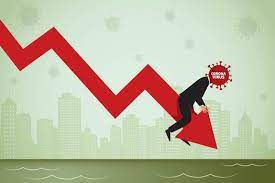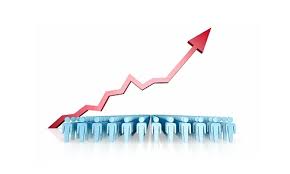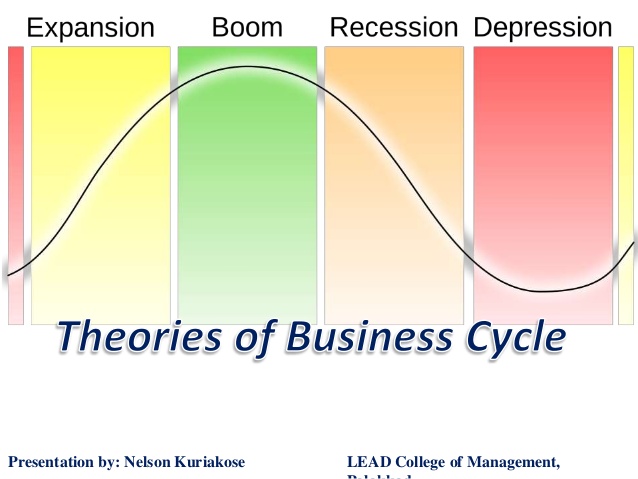Economic Business Cycle theories have been presented to point out the causes of trade cycle but there is no single theory which covers all the causes of trade cycle. Any how, here we discuss some prominent theories of business cycle.

1 – Climatic Theory Or Sun-Spot Theory.
The theory has been presented by Jevons. According to him, the main cause of economic fluctuations is the changes in climatic conditions. He ‘says that spots appear on the surface of the sun after regular intervals which affect the emission of heat and conditions of rainfalls. Production in agriculture sector is adversely effected .and incomes of the farmers are reduced.
A low income in agriculture sector causes a decrease in the demand for industrial goods. So depression in agriculture sector is transferred to industrial and other sectors of the economy. When the spots disappear, rainfalls and climatic conditions become favorable, output in agriculture sector increases. Incomes of the farmers expand and they increase demand for industrial products. It means overall prosperity and depression occurs due to changes in climatic conditions.
Comments:-
Climatic changes may cause partial and temporary fluctuations but overall ups and downs are due to so many other reasons. If trade cycle is due to climatic changes then there should be no trade cycle in industrial countries. Actually industrial countries are more sensitive to trade cycle than agricultural countries.The theory is not based on facts rather it is based on assumptions.
2- Psychological Theory:-
Professor Pigou explains trade cycle based upon human psychology. There are moods of optimism and pessimism which are responsible for the alternating phases of trade cycle. When business community is optimistic about earning profit, investment increases. Increase in investment expands the level of national income and employments. At prosperity fear of recession prevails among business community and they becomes pessimistic about earning profit without any sound reason. This behavior reduces investment and contracts the level of income and employment.
Comments:-
No doubt the waves of optimism and pessimism stimulate the various phases of trade cycle but up-turn and down-turn is not due to psychological reasons.
Revival and recession occurs due to sound and genuine reasons.
3- Monetary Theory:-
This theory is associated with the name of R.G. Hawtrey According to him; the only factor which causes fluctuations in business activity is the variations in the supply of money. Most of the business is done with borrowed money. When business prospects are bright, banks advance credit on easy terms and conditions. Cheap and easy credit facilities are very helpful in the expansion of business activity. Aggregate demand is increasing because workers are getting employment at high wage rates. This state of affairs prolongs for some years.
All of a sudden banks start thinking that they have gone too’ far in advancing credit. They apply brake on the further expansion of credit; it is felt like a bomb by business community. They are forced to reduce investment. The business activities are slowed down. It causes unemployment and contraction of economic activities.
Facts You Must Know About Economic Business Cycle And Causes Behind That.

Comments:
The theory provides a reasonable reason for the explanation of occurrence of trade cycle.A fluctuation in volume of credit has an impact on business activities.The theory attributes changes in credit the only reason for trade cycle, but this is not fact.The decisions of banks to increase or reduce credit facility are usually not sudden.
5- Under Consumption Theory
This theory assumes that main cause of business fluctuation is under consumption in the economy. During prosperity the income distribution in the economy becomes uneven. The majority of population receive a small portion of total national income where as a small minority receives major portion.
Distribution of income in favor of profit earning class increases the volume of savings. Demand for consumption goods decreases which leads to contraction in their output. Ultimately, this state of affairs pushes the economy into depression.
Comments:-
This theory contains some element of truth but it does not provide satisfactory explanations. If under consumption theory is true then consumption goods industries should fluctuate more than investment goods industries. Practically, the situation is opposite.It explains the cause of depression and is silent about the phase of revival.
4 Keynes’ Theory:-
Keynes’ “General Theory” also provides an explanation of trade cycle, because trade cycle is nothing more than the fluctuations in income, output and employment.
According to Keynes, “fluctuations in the level of national income and employment are due to changes in the volume of investment”. Investment is determined by two factors i.e., the rate of interest and expected rate of profit (MEC). Interest is relatively stable factor and it does not change in the short-run. Therefore it plays no significant role in cyclical fluctuations. The other factor, MEC (expected r.ite of profit) changes frequently because it is mostly dependent on expectations of earning profit when business community is expecting to earn abnormal profit and MEC exceeds the rate of interest, investment expands.
An increase investment leads to many times more increase in income and employment through the positive effect of multiplier. So expansion phase of trade cycle is due to increase in investment resulting from a rise in MEC.
On the other hand, a fall in MEC will reduce the volume of investment. Reduction in investment will contract income and employment through the inverse action of multiplier. It means the phase of i recession starts due to fall in MEC.
The intensity of cyclical fluctuations depends upon the value of multiplier. In the end we may conclude that economic fluctuations are due to MEC.
Comment:-
Keynes’ theory provides explanation about cyclical fluctuation but considers the effect of multiplier only. The theory ignores the effect of other important factors accelerator.
5- Modern Theory:-
Modem theory explains trade cycle in terms of interaction between multiplier and accelerator. According to Hicks, intensity of economic fluctuations is much more due to combined effect of multiplier and accelerator.An increase in investment leads to many times more increase in national income through the working of multiplier.
For example, if the value of multiplier is 5, an investment of Rs.100 will raise national income by Rs.500.The effect of accelerator increases the speed of investment in economy. An increase in.-national income by Rs.500 will raise aggregate consumption by Rs. 400 if marginal propensity to consume (MPC) is 4/5. Further investment will be required to meet the additional demand for consumption goods of Rs. 400 Suppose capital goods worth Rs. 10,000 can produce consumption goods worth Rs. 400 regularly. It means there will be further investment of Rs. 10,000 which will cause further increase in national.
The accelerator like multiplier works in both directions. If the demand for consumer goods deceases, it leads to a fall in the demand for capital goods, As a result of this, national income will start contracting rapidly due to combined effect of multiplier and accelerator.Therefore modern theory of trade cycle explains reasonably the causes of trade cycle in the economy.
